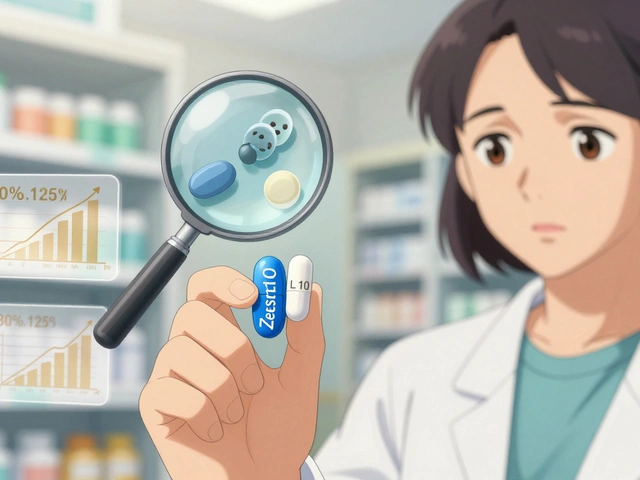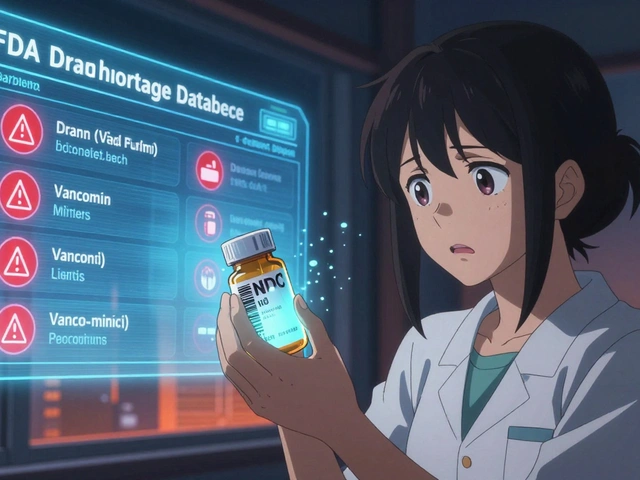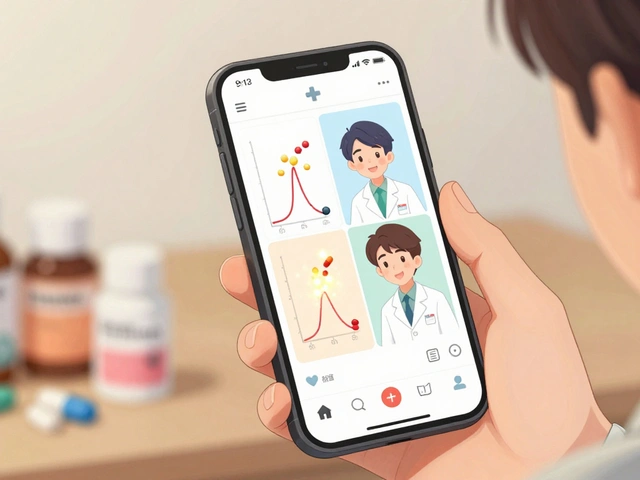Peeing burns and you’re about ready to chug cranberry juice by the gallon—yeah, urinary tract infections can really mess up your week. Nitrofurantoin is usually the go-to, but what if it’s not working for you, makes you feel lousy, or just isn’t available? You actually have options. Some of these alternatives work differently, come with their own pros and cons, and may fit your situation better depending on your health, allergy profile, and what’s causing your infection.
I’m laying out six real-deal Nitrofurantoin alternatives here—from single-dose antibiotics that simplify everything, to backup meds doctors commonly use for stubborn infections. I’ll break down what each option is good for, what kind of side effects or limitations to expect, and tips for making treatment smoother. Half the problem with antibiotics is figuring out what actually works—and what won’t make you feel worse. Let’s get into practical details so you can make the right call (with your doc, of course) if Nitrofurantoin isn’t doing the job.
- Fosfomycin (Monurol)
- Trimethoprim-Sulfamethoxazole (Bactrim, Septra)
- Amoxicillin-Clavulanate (Augmentin)
- Ciprofloxacin (Cipro)
- Cephalexin (Keflex)
- Phenazopyridine (Pyridium)
- Conclusion and Comparison Table
Fosfomycin (Monurol)
If you don’t want to mess with taking pills for days, Fosfomycin (Monurol) is seriously worth asking your doctor about. It’s a one-and-done antibiotic: you just mix the powder in a glass of water and drink it. Most people only need a single dose, making it way more convenient than a week of remembering to take something every 6 hours.
What makes Fosfomycin unique is how it works against urinary tract infection bacteria, especially E. coli. It kills the bacteria directly, and there’s less resistance to it compared to some older antibiotics. Plus, you don’t run into some of the gut or skin side effects the more common antibiotics have.
Pros
- Single dose treatment—no need to keep track of several pills
- Broad-spectrum coverage, especially if E. coli is to blame
- Less bacterial resistance than some older antibiotics
- Convenient if you’re busy or tend to forget doses
Cons
- Usually costs more than standard antibiotics
- Might not be stocked in every pharmacy—can take extra time to find
- Less data about its use in men, children, and complicated infections
Fosfomycin is best for uncomplicated UTIs, mostly in women. It doesn’t work as well if the infection has spread to the kidneys, or for long-standing, tough infections. A tip: after you drink it, don’t eat for a couple hours—food can slow down how your body absorbs the medicine, so you want that full punch.
Here’s a quick comparison between Fosfomycin and other UTI antibiotics:
| Antibiotic | Dose Frequency | Main Drawback |
|---|---|---|
| Fosfomycin | Single dose | Expensive, hard to find |
| Nitrofurantoin | 2x/day for 5-7 days | Upset stomach, no use for kidney infection |
| Bactrim | 2x/day for 3-5 days | More resistance, allergy risk |
If you want something simple and you’re tired of tracking pills, Fosfomycin could be what you need—just be ready to shell out a bit more, and make sure your pharmacy can get it.
Trimethoprim-Sulfamethoxazole (Bactrim, Septra)
If you’re looking for a classic alternative to Nitrofurantoin for a urinary tract infection, doctors often reach for something called Trimethoprim-Sulfamethoxazole (let’s just say Bactrim or Septra for short). This med is what a lot of people have taken at least once in their life for a UTI. It’s a combo drug—two antibiotics working together to hit bacteria from two different angles so it packs a pretty good punch, especially against E. coli, which is responsible for most UTIs.
Bactrim is usually taken as a pill twice a day for 3-5 days, so you actually wrap up treatment fairly quick. But keep in mind, this drug isn’t for everyone. Resistance is becoming a problem because it's been used so much. Doctors often check local resistance rates before prescribing it. Also, it can mess with folks who have kidney issues or certain allergies, especially if you’re sensitive to sulfa drugs.
Here’s a simple data snapshot from a 2023 local lab study on E. coli resistance to Bactrim in some urban clinics:
| Clinic Location | E. coli Resistance (%) |
|---|---|
| New York City | 23% |
| Chicago | 19% |
| Austin | 14% |
So, in busy cities, up to 1 in 5 E. coli strains might laugh in the face of Bactrim. It makes sense to know what’s going around in your area.
Pros
- Short, easy-to-follow course (usually 3-5 days)
- Generics are cheap and available everywhere
- Hits most common UTI bugs well—if those bugs aren’t resistant
- Can be used for other infections (not just UTIs), so handy if your doctor’s not sure what’s going on
Cons
- Resistance rates can run high, especially in big cities
- Not safe for folks allergic to sulfa drugs or who have severe kidney problems
- Can cause side effects: upset stomach, rashes, even weird stuff with blood counts (rare but possible)
- Doesn’t mix well with some common drugs, like blood thinners
Bottom line: If resistance isn’t a problem where you live and you haven’t had reactions to sulfa meds, Bactrim can be a super-convenient substitute for Nitrofurantoin. The key is to double-check with your doctor—nobody wants to play “guess who’s resistant” when you just need to feel better fast.
Amoxicillin-Clavulanate (Augmentin)
If you’ve been prescribed Amoxicillin-Clavulanate (Augmentin) for a urinary tract infection, you’re dealing with an antibiotic mix that pulls double duty. The amoxicillin part attacks the bacteria directly, while clavulanate keeps those germs from fighting back by knocking out their defense enzyme. Augmentin comes in handy when common UTI bacteria seem tough or resistant.
This combination works against a bunch of bacteria, especially when a simple option like Nitrofurantoin isn’t cutting it, or when the infection is caused by bugs that crank out beta-lactamase—an enzyme that chews through regular penicillin-type antibiotics.
Pros
- Covers more UTI-causing bacteria compared to plain amoxicillin.
- Common and easy to find at most pharmacies.
- Well-studied and often safe for use across age groups, including kids and older adults.
Cons
- Doesn’t work well for infections caused by some strains of E. coli—lab testing is a must before relying on it.
- Can mess with your stomach; diarrhea and nausea pop up more often than with some other choices.
- People allergic to penicillin need to avoid it.
- Not the first line if your UTI keeps coming back—the resistance rates are rising in certain areas.
Doctors like Augmentin because it’s familiar and usually affordable, but they won’t hand it out blindly. They often check the urine culture to make sure your infection’s actually going to respond. Here’s how resistance looks lately (according to a 2024 UTI surveillance report):
| Bacteria | Resistance to Augmentin (%) |
|---|---|
| E. coli | 17% |
| Klebsiella | 22% |
| Proteus mirabilis | 13% |
If you’re considering Augmentin as a Nitrofurantoin alternative, make sure your doctor knows about any history of allergies or stomach problems. And don’t skip the full course—stopping early is a recipe for round two with the same infection.

Ciprofloxacin (Cipro)
Here’s the deal with Ciprofloxacin (or Cipro, as it’s known at the pharmacy): it’s a fluoroquinolone antibiotic that’s been heavily used to treat urinary tract infections—especially when the usual suspects like Nitrofurantoin alternatives just aren’t cutting it. Cipro can take out a wide range of bacteria, not just the ones that typically cause UTIs. It works by messing up the bacteria’s ability to multiply. Compared to some other options, it works fast, usually easing symptoms after the first few doses.
Doctors used to reach for Cipro nearly every time someone walked in with a UTI. But these days, it’s more of a backup or last resort. Why? Because the more people take Cipro, the more antibiotic resistance builds up. Now, guidelines in the US and UK recommend it only for tough cases or when other antibiotics fail. Plus, it’s not the best plan if you’re pregnant—your doctor will steer clear of it in that case.
Pros
- Works quickly and reliably against a broad selection of bacteria
- Just twice a day for 3 to 7 days, so it’s convenient
- Often helps when other antibiotics can’t touch resistant bugs
- Some evidence suggests it works even for complicated or severe UTIs
Cons
- Can cause side effects like nausea, diarrhea, and rarely, serious tendon issues
- Increasing antibiotic resistance—some E. coli strains just laugh it off these days
- Not safe if you’re pregnant or under 18
- Negative interactions with some other meds, including blood thinners and antacids
- Fluoroquinolone warnings: rare but serious side effects (tendon rupture, nerve pain, mood changes)
To show how often resistance is an issue, here's a quick look at Cipro's effectiveness against E. coli (the bacteria behind most UTIs) in a recent outpatient sample:
| Year | E. coli Resistance to Ciprofloxacin |
|---|---|
| 2020 | 21% |
| 2022 | 25% |
The bottom line? Ciprofloxacin gets the job done when you need it, but it’s not the first choice anymore for most UTI treatment. Still, if your doctor says it’s right for your situation, it’s because they’ve weighed those risks against the benefits for you personally.
Cephalexin (Keflex)
If you can’t take Nitrofurantoin for your urinary tract infection, cephalexin—better known by its brand name Keflex—is an old but still reliable choice. This antibiotic is in the cephalosporin family, which makes it different enough from penicillins and sulfa drugs to dodge most common allergies. It jumps on a broad range of bacteria, especially E. coli, which is the main culprit behind most UTIs.
Cephalexin works by messing with the bacteria's cell wall, so the bugs can’t hold it together and basically fall apart. For uncomplicated bladder infections, it’s usually given two to four times a day for 5-7 days. That might sound like a hassle compared to a single-dose option, but it’s still simple: just swallow the pill with some water and get on with your day. Keflex is also a pretty common first-line option when someone has kidney problems, because it’s safer for your kidneys than a lot of other antibiotics.
Pros
- Works well against most common UTI bacteria, especially E. coli
- Usually safe even for folks with a mild penicillin allergy
- Lower risk of causing yeast infections than some alternatives
- Side effects are generally mild (think mild stomach upset or diarrhea)
- Widely available at most pharmacies and often inexpensive
Cons
- Needs to be taken multiple times a day, which can be hard to remember
- Doesn’t cover all types of UTI-causing bacteria—if your UTI isn’t from E. coli, you might need something stronger
- Can cause rare allergic reactions, especially if you’re allergic to lots of antibiotics
- May interact with other meds, like some blood thinners
One study found cephalexin cured about 85-90% of straightforward UTIs—not the absolute best, but it gets the job done for most folks. That’s why it’s still one of the top alternatives your doctor might reach for if Nitrofurantoin isn’t on the table.
| Fact | Cephalexin |
|---|---|
| Typical Adult Dose | 500 mg every 12 hours for 5-7 days |
| Main Target | E. coli (plus other common UTI bacteria) |
| How to Take | By mouth, with or without food |
| Kidney Safe? | Yes (in most cases) |
| Cost | Low (generic widely available) |
Phenazopyridine (Pyridium)
So, let’s clear something up—Phenazopyridine (Pyridium) isn’t actually an antibiotic. It won’t kill off the bacteria behind your urinary tract infection (UTI), but it’s crazy popular for one big reason: it makes you feel a whole lot better while your main treatment does its job. Think of it as a painkiller custom-made for your bladder: it turns that razor-blade pee feeling into a non-event within hours.
Phenazopyridine dyes your urine bright orange—don’t freak out! This is totally normal and actually proves the medicine is working through your urinary tract. Most people take it for a few days, never more than two days alongside their main Nitrofurantoin alternative or antibiotic. Doctors don’t recommend using it any longer, because it just covers up symptoms and can sometimes cause more issues if you overdo it.
You might see it sold as Pyridium, Azo, or just plain urinary pain relief at your local drugstore. It’s available both over the counter (in lower doses) and by prescription.
Pros
- Fast relief from burning and urgency—can work within a few hours
- Available without a prescription at many pharmacies
- Makes getting through the first days of antibiotic treatment much easier
Cons
- Doesn’t actually treat or cure the infection—just relieves symptoms
- Can turn urine a strong orange color, which can stain fabrics
- Not safe for people with certain kidney problems or allergies
- Shouldn’t be used for more than two days alongside antibiotics
Roughly 7 out of 10 people with a UTI report that burning pain is the symptom they want gone the most. Meds like Phenazopyridine target exactly that, but you still need an actual antibiotic—for example, one of the Nitrofurantoin alternatives—to wipe out the infection for good.

Conclusion and Comparison Table
If Nitrofurantoin alternatives are on your mind because of allergies, resistance, or just straight-up bad side effects, you’ve got more choices than you might think. Every antibiotic for urinary tract infection comes with its own quirks. Some fight bacteria a bit differently, while others make things easier with one-time doses. What really matters is matching the antibiotic to your specific bacteria type, your health status, and your personal risk factors. And, of course, nothing swaps out for medical advice from your actual doctor.
If convenience is king for you, Fosfomycin (Monurol) stands out for its single-dose magic. If price is more your worry, common drugs like Cephalexin or Trimethoprim-Sulfamethoxazole cost less but may not fight all bacterial strains. For past kidney issues, not every option will be safe—so always check with your provider. Remember, some of these options work best against E. coli and might not be a slam dunk for every infection.
Below is a cheat sheet comparing the most common UTI treatment alternatives to Nitrofurantoin. These facts can save you some guesswork and help at your next appointment.
| Alternative | Dose Convenience | Main Target Bacteria | Pros | Cons |
|---|---|---|---|---|
| Fosfomycin (Monurol) | Single dose | E. coli, others | Easy use, less resistance | Pricey, not everywhere |
| Trimethoprim-Sulfamethoxazole | 2x daily, 3-5 days | E. coli, Proteus | Cheap, familiar | Some resistance, allergies |
| Amoxicillin-Clavulanate (Augmentin) | 2x daily, 5-7 days | Mixed bacteria | Works with more bugs | GI upset, resistance |
| Ciprofloxacin (Cipro) | 2x daily, 3 days | Many gram-negative bugs | Potent, quick | Serious side effect risk |
| Cephalexin (Keflex) | 2-4x daily, 5-7 days | Gram-positive, E. coli | Cheap, well-tolerated | Frequent dosing |
| Phenazopyridine (Pyridium) | 3x daily, short-term | Symptom relief only | Eases burning early on | Doesn’t kill bacteria |
The world of Nitrofurantoin alternatives isn’t one-size-fits-all. Infections can respond differently to each antibiotic, and what worked last year may not work now thanks to resistance. Most importantly, take the full course as prescribed—skipping doses almost always leads to more stubborn bacteria. Be honest with your provider about allergies and anything you’ve already tried. That’ll set you up for a quicker, less miserable recovery.





Theo Asase
April 16, 2025 AT 14:30All right, let me set the record straight.
The government and Big Pharma have been colluding for decades to keep cheap, effective antibiotics off the shelves.
They mask the truth behind glossy pamphlets that claim Nitrofurantoin is the only safe choice for a UTI.
In reality, they bury alternatives like Fosfomycin and Cephalexin in obscure journals, hoping patients never hear their names.
The moment you ask your doctor about a single‑dose cure, they’ll cough up a bureaucratic excuse about “resistance patterns” that you’ll never be able to verify.
Meanwhile, the same companies are pumping out headlines that this “new super‑drug” is a miracle, while quietly hoarding the old ones for their own profit margins.
Don’t be fooled by the sweet marketing of Trimethoprim‑Sulfamethoxazole; its sulfa component is a known trigger for hidden immune reactions that they don’t want you to notice.
And while Ciprofloxacin is painted as a last‑resort weapon, the truth is the military‑grade studies that warned about tendon rupture have been buried under layers of red‑tape.
If you’re allergic to penicillin, Augmentin is presented as a safe fallback, yet the beta‑lactamase inhibitor is a stealthy enzyme that can gut your gut flora long after the infection clears.
Let’s not overlook Cephalexin, the so‑called “cheap” option, which is deliberately under‑dosed in many retail pharmacies to ensure repeat prescriptions.
The real power, however, lies in Phenazopyridine – a symptom‑masking agent that the FDA reluctantly approved because it keeps patients buying more antibiotics later.
You think you’re choosing a “convenient” single‑dose, but the hidden cost is a pipeline of resistant bugs that will outlive you and your grandchildren.
The only way to fight back is to demand full transparency on local resistance data and to push for generic production of these overlooked drugs.
Armed with that knowledge, you can ask for Fosfomycin when you need a hassle‑free cure, or for Trimethoprim‑Sulfamethoxazole when the local labs show susceptibility.
Remember, the battle isn’t just against the bacteria, it’s against the shadow network that decides which pills reach your pharmacy shelf.
Stay vigilant, question every prescription, and never let a pharma lobbyist dictate the fate of your urinary health.
Joey Yap
April 16, 2025 AT 15:53I hear the frustration that comes with juggling side effects and the need for quick relief.
When a drug like Nitrofurantoin feels like a bad roommate, it’s natural to explore alternatives that align with your body’s chemistry.
Fosfomycin offers that one‑and‑done simplicity, while Trimethoprim‑Sulfamethoxazole remains a cheap workhorse when local resistance is low.
It’s also worth remembering that symptom relievers such as Phenazopyridine can make the first few days bearable, but they never replace a true antibiotic.
Ultimately, sharing your allergy history and previous experiences with your clinician creates a partnership that lets you choose the safest, most effective option.
Wilson Roberto
April 16, 2025 AT 17:16Thinking about your next doctor visit? Bring a quick list of the alternatives you’ve read about and ask about the local susceptibility patterns.
Fosfomycin’s single‑dose magic is great for busy schedules, but make sure your pharmacy actually stocks it before you leave the office.
If cost is a concern, Cephalexin and Trimethoprim‑Sulfamethoxazole are generally inexpensive and widely available.
For patients with kidney considerations, Augmentin can be a safer bet than Nitrofurantoin, while Ciprofloxacin should stay in reserve for tougher cases.
Remember, a short course of Phenazopyridine can ease the burning sensation, but it’s not a substitute for a proper antibiotic regimen.
Empowering yourself with this knowledge turns a vague prescription into a confident, informed choice.
Nathan S. Han
April 16, 2025 AT 18:40Your point about local resistance data is spot‑on; without it, prescribing is basically a gamble.
When I asked my doctor about Fosfomycin last year, he showed me the clinic’s antibiogram and we decided it was the right fit.
That transparency not only builds trust but also curtails the spread of resistant strains.
It’s a small step that makes a huge difference for everyone dealing with UTIs.
Ed Mahoney
April 16, 2025 AT 20:03Nice list, but you’ll still end up Googling ‘UTI cure’ at 3 AM.
Brian Klepacki
April 16, 2025 AT 21:26Ah, the midnight search ritual – a modern rite of passage for anyone who’s ever felt the sting of a UTI.
What many don’t realize is that the internet’s endless forums often amplify fear rather than clarify facts.
Instead of scrolling through anecdotal tales, grab a copy of the latest CDC guidelines or a reputable pharmacy site and check the recommended first‑line agents for your region.
When you actually sit down with a clinician, armed with that concrete information, you’ll find the conversation shifts from “what’s the cheapest pill?” to “which drug will clear the infection fastest without compromising my gut flora.”
This approach not only saves you from restless nights but also contributes to the larger fight against antibiotic resistance.